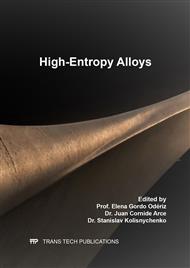[1]
B.Cantor, I.T.H. Chang, P. Knight et al, Mater. Sci. Eng. A 213 (2004) 375-377.
Google Scholar
[2]
J. W. Yeh, S.K. Chen, S.J. Lin, J.Y. Gan, T.S. Chin, T.T. Shun, Advanced Engineering Materials. 6 (2004) 299-303.
Google Scholar
[3]
Bernd Gludovatz et al. Science. 345 (2014) 1153.
Google Scholar
[4]
Z.Wu, H. Bei, F. Otto, G.M. Pharr and E.P. George, Intermetallics. 46 (2014) 131-140.
Google Scholar
[5]
Z. Wu, H. Bei, G.M. Pharr and E.P. George, Acta Materials. 81 (2014) 428-441.
Google Scholar
[6]
Z.Wu, H.Bei, Mater. Sci. Eng. A 640 (2015) 217-224.
Google Scholar
[7]
Z. Wu, Y.F. Gao, H.Bei, Scripta Materials. 109 (2015) 108-112.
Google Scholar
[8]
C.M. Lin, H.L. Tsai, Equilibrium phase of high-entropy FeCoNiCrCu0.5 alloys at elevated temperature, J. Alloy. Comp. 489 (2010) 30-35.
DOI: 10.1016/j.jallcom.2009.09.041
Google Scholar
[9]
C.M. Lin, H.L. Tsai, H.Y. Bor, effect of annealing treatment on microstructure and properties of high-entropy Cu0.5CoCrFeNi alloys, Intermetallics. 18 (2010) 1244-1250.
DOI: 10.1016/j.intermet.2010.03.030
Google Scholar
[10]
C.M. Lin, H.L. Tsai, H.Y. Bor, effect of aging treatment on microstructure and properties of high-entropy Cu0.5CoCrFeNi alloys, Mater. Chem. Phys. 128 (2011) 50-56.
Google Scholar
[11]
C.J. Tong, M.R. Chen, S.K. Chen, J.W. Yeh, T.T. Shun, S.J. Lin, S.Y. Chang, Metall. Mater. Trans. A 36 (2005) 1263-1269.
Google Scholar
[12]
Penghui Wu, Zhen Peng, Ning Liu, Muye Niu, Zhixuan Zhu, Xiaojing Wang, Mater. Trans. 57-1, 5-8, (2016).
Google Scholar
[13]
Zhu JM, Fu HM, Zhang HF, Wang AM, Li H, Hu ZQ. Mater Sci Eng A. 527 (2010) 6975-6979.
Google Scholar
[14]
Hsu CY, Yeh JW, Chen SK, Shun TT. Metall Mater Trans A. 35 (2004) 1465-1469.
Google Scholar
[15]
Zhu JM, Fu HM, Zhang HF, Wang AM, Li H, Hu ZQ. Mater Sci Eng A. 527 (2010) 7210-7214.
Google Scholar
[16]
F. Otto, Y. Yang, H. Bei, E.P. George, Acta Mater. 61 (2013) 2628-2638.
Google Scholar
[17]
Y. Zhang et al., Solid solution formation criteria for high entropy alloys, Mater. Sci. Forum 561 (2007) 1337.
Google Scholar
[18]
S. Guo et al., Effect of valence electron concentration on stability of fcc or bcc phase in high entropy alloys, J. Appl. Phys. 109 (2011) 103505.
DOI: 10.1063/1.3587228
Google Scholar
[19]
Y. Dong, Y. Lu, L. Jiang, T. Wang and T. Li, effect of electro-negativity on the stability of topologically close-packed phase in high entropy alloys, Intermetallics. 52 (2014) 105-109.
DOI: 10.1016/j.intermet.2014.04.001
Google Scholar
[20]
X. Yang and Y. Zhang, Mater. Chem. Phys. 132 (2012) 233.
Google Scholar
[21]
Z. Wang, Y. Huang, Y. Yang, J. Wang, C.T. Liu, Atomic-size effect and solid solubility of multicomponent alloys, Scr. Mater. 94 (2015) 28e31.
Google Scholar
[22]
Akira Takeuchi, Akihisa Inoue. Classification of Bulk Metallic Glasses by Atomic Size Difference, Heat of Mixing and Period of Constituent Elements and Its Application to Characterization of the Main Alloying Element. Materials Transactions. 46 (2005) 2817-2829.
DOI: 10.2320/matertrans.46.2817
Google Scholar



